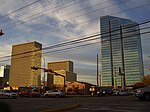Lamar High School (Houston)

Lamar High School is a comprehensive public secondary school located in Houston, Texas, United States. It is a part of the Houston Independent School District (HISD). Lamar High School, was established in 1936 in memory of Mirabeau B. Lamar (1798–1859), a leader in the Texas Revolution and the second President of the Republic of Texas. Lamar has a four-year program, serving grades 9 through 12. The school is located in the Upper Kirby district, serving the Houston neighborhoods of River Oaks and Montrose, the incorporated city of West University Place, a portion of the city of Southside Place, and other Houston subdivisions. Lamar offers neighborhood, Advanced Placement, and IB Diploma (International Baccalaureate) programs. It also hosts a business magnet program offering business management courses that works in conjuncture with the Houston business community to provide internships and university scholarships. Lamar's IB Diploma programs is one of six in HISD, and consistently graduates the largest number of IB Diploma diploma candidates in Texas.
Excerpt from the Wikipedia article Lamar High School (Houston) (License: CC BY-SA 3.0, Authors, Images).Lamar High School (Houston)
Westheimer Road, Houston
Geographical coordinates (GPS) Address External links Nearby Places Show on map
Geographical coordinates (GPS)
| Latitude | Longitude |
|---|---|
| N 29.74074 ° | E -95.42655 ° |
Address
Lamar High School
Westheimer Road 3325
77098 Houston
Texas, United States
Open on Google Maps








